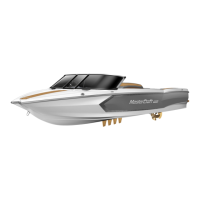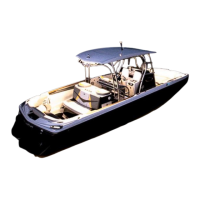DOLPHIN . . . A group of piles driven close together
and bound with wire cables into a single structure.
DRAFT . . . The depth a boat floats in the water.
EBB . . . A receding current.
FATHOM . . . Six feet down in the water.
FENDER . . . A cushion, placed between boats or be-
tween a boat and a pier to prevent damage.
FIGURE EIGHT KNOT . . . A knot in the form of a
figure eight, placed in the end of a line to prevent the
line from passing through a grommet or a block.
FLOOD . . . An incoming current.
FLOORBOARDS . . . The surface of the deck; usually
removable sections placed for access to storage areas
or the drive train.
FORE-AND-AFT . . . In a line parallel to the keel.
FORWARD . . . Toward the bow of the boat.
FOULED . . . Any piece of equipment that is jammed
or entangled.
GEAR . . . A general term for ropes, blocks, skis, boards,
and other equipment brought aboard.
GIVE-WAY VESSEL . . . A term used to describe the
vessel that must yield in meeting, crossing or overtak-
ing situations (see Rules of the Open Water section).
GRAB RAILS . . . Hand-hold fittings mounted for per-
sonal safety when moving around the boat.
GUNWALE . . . (also gunnel) The upper edge of a boat’s
sides.
HARD CHINE . . . An abrupt intersection between the
hull side and the hull bottom created to affect a boat’s
wake and handling.
HEADING . . . The direction in which a vessel’s bow
points at any given time.
HEADWAY . . . The forward motion of a boat.
HULL . . . The main body of a vessel.
INBOARD . . . A type of boat in which the motor is
inside the hull.
INTRACOASTAL WATERWAY (ICW) . . . Bays, riv-
ers and canals along the coasts, such as the Gulf of Mexico
and Atlantic coasts, connected so that vessels may travel
without going into the sea.
JETTY . . . A structure, usually masonry, projecting out
from the shore. A jetty may protect a harbor entrance.
KEEL . . . The center line of a boat; the backbone of a vessel.
KNOT . . . The measure of speed equal to one nautical
mile (6076 feet) per hour.
3-2
NAUTICAL
TERMINOLOGY

